Should Nest Boxes Be Cleaned Between Same Year Nesting
15 things you should know about Dictionaries in Python
Guidelines to use dictionaries in Python

i. What is a Python dictionary?
A dictionary is an unordered and mutable Python container that stores mappings of unique keys to values. Dictionaries are written with curly brackets ({}), including key-value pairs separated by commas (,). A colon (:) separates each key from its value.
Three dictionaries are shown below, containing the population of the five largest German language cities, list of products, and student'southward grades.
2. Create a lexicon with dict() constructor
Dictionaries can also be created with the built-in office dict(**kwarg). This function takes an capricious number of keywords arguments (arguments preceded by an identifier kwarg=value) as input.
We can as well create a lexicon using some other dictionary in combination with keyword arguments (dict(mapping, **kwarg)) equally follows:
Alternatively, nosotros can construct a dictionary using an iterable (eastward.g. listing of tuples). Each tuple must contain 2 objects. The first object becomes the fundamental and the second becomes the value of the dictionary.
Lastly, we can create a dictionary using two lists. Get-go, we have to build an iterator of tuples using zip(*iterables) function. Then, nosotros utilize the dict([iterable, **kwarg]) function to construct the lexicon, equally we did previously.
three. Access values in a dictionary
To access dictionary values, we cannot use a numeric index (as we do with lists or tuples), since the dictionaries are unordered containers. Instead, we enclose the primal using square brackets([]). If we endeavour to access a value using an undefined key, a KeyError is raised.
To avoid getting an exception with undefined keys, nosotros tin utilize the method dict.go(key[, default]). This method returns the value for key if key is in the dictionary, else returns default. If default is not provided, it returns None (but never raises an exception).
4. Insert elements in a dictionary
To insert an chemical element in a dictionary, we tin use square brackets every bit follows:
To insert multiple items at once, we can use the method dict.update([other]). This method updates the dictionary with the central/value pairs from other, overwriting existing keys.
Equally shown to a higher place, the .update() method accepts equally an argument not simply another dictionary, but as well a list of tuples or keyword arguments. This method modifies the dictionary in-place, returning None.
v. Alter elements in a dictionary
We can change the value of an item by accessing the cardinal using foursquare brackets ([]). To alter multiple values at once, we can utilise the .update() method, since this function overwrites existing keys.
Afterward, we increase the price of a sofa 100 units, and we change the grades of two students.
6. Remove elements in a dictionary
To remove an element in a dictionary, nosotros tin can use either the del dict[central] keyword or the dict.pop(cardinal[, default]) method.
The del dict[cardinal] keyword removes the given element from the dictionary, raising a KeyError if central does not exists.
If key exists in the lexicon, the dict.pop(key[, default]) method removes the item with the given primal from the dictionary and returns its value. On the contrary, if central does non exist in the dictionary, the method returns the default value. If no default value is provided and key does not exist, the .pop() method will heighten an exception (KeyError).
7. Cheque if a central exists
To check whether a central exists in a lexicon, we have to use a membership operator. Membership operators are used to examination whether a value is plant in a sequence (e.g. strings, lists, tuples, sets, or dictionaries). There are two membership operators, as explained below.
- in → Evaluates to true if the object on the left side is included in the object on the right side.
- not in → Evaluates to truthful if the object on the left side is not included in the object on the right side.
As shown above, membership operators (in and not in) can be used to bank check whether a key exists in a dictionary, only they can as well be used with other sequences in the following fashion.
8. Copy a dictionary
To copy a lexicon, we can only apply the dict.copy() method. This method returns a shallow re-create of the dictionary. We take to exist careful with shallow copies, since if your dictionary contains another container-objects like lists, tuples, or sets, they will exist referenced again and not duplicated.
To avert this trouble, nosotros tin create a deep copy using copy.deepcopy(x) function (divers in the copy module) as follows:
The difference between shallow copies and deep copies is only relevant when the dictionary contains other objects like lists, since those objects volition be referenced instead of duplicated (shallow copy). To create a fully contained clone of the original dictionary, we have to make a deep copy.
If you want to know more virtually how to re-create a lexicon, you can read the following article where the differences between shallow copies and deep copies are explained in particular.
It is important to bear in mind that the = operator does not brand a copy of the dictionary. It is only another name to refer to the same dictionary, meaning whatsoever modification to the new dictionary is reflected in the original one.
9. Determine the length of the dictionary
To determine how many key-value pairs the dictionary contains, nosotros tin utilise the len() office. This function returns the number of items of an object. The input of the office tin be a dictionary, but too another type of sequence such as a string, list, tuple, or set.
ten. Loop through a dictionary
Iterating through keys
To iterate over the keys, we can use the dictionary directly in a for loop as follows:
Alternatively, nosotros tin use the dict.keys() method. This method returns a view object, containing the keys of the lexicon.
Iterating through values
If you just need to work with the values of a lexicon, then y'all tin utilize the dict.values() method in a for loop. This method returns a view object that contains the values of the lexicon.
We tin compute how many people live in the 5 largest German cities using dict.values() method every bit follows:
Every bit we can observe, almost 9 million people alive in the 5 largest High german cities.
Iterating through items
When you're working with dictionaries, it's probable that you lot demand to use the keys and the values. To loop through both, you can apply the dict.items() method. This method returns a view object, containing cardinal-value pairs as a list of tuples.
We can determine the educatee with the everyman exam score using the dict.items() method in combination with a for loop as follows:
Equally shown above, Normando is the student with the lowest test score (2.5).
11. Lexicon comprehensions
Python for-loops are very handy in dealing with repetitive programming tasks; yet, at that place is another alternative to achieve the same results in a more efficient style: lexicon comprehensions.
Dictionary comprehensions allow the creation of a dictionary using an elegant and simple syntax: {key: value for vars in iterable}. In addition, they are faster than traditional for-loops.
Nosotros tin filter the products with a price lower than 100 euros using both a traditional for-loop and a lexicon comprehension.
As we can observe, dictionary comprehensions provide the same results as traditional for-loops in a more elegant way.
12. Nested dictionaries
Nested dictionaries are dictionaries that contain other dictionaries. We can create a nested dictionary in the same way nosotros create a normal dictionary using curly brackets ({}).
The post-obit nested dictionary contains information about 5 famous works of art. As nosotros tin observe, the values of the lexicon are other dictionaries as well.
We can likewise create the prior nested lexicon using the dict() constructor, passing the key: value pairs as keyword arguments.
To access elements in a nested dictionary, we specify the keys using multiple square brackets ([]).
If you want to know more about nested dictionaries, you can read the following commodity where, how to work with nested dictionaries (due east.g. update items, alter elements, and loop though) is explained in particular.
thirteen. Alternative containers : OrderedDict, defaultdict, and Counter
The collections module provides alternative container datatypes to built-in Python containers. Iii dictionary subclasses independent in the collections module that are pretty handy when working with Python are: (i)OrderedDict, (2)defaultdict, and (3)Counter.
OrderedDict
OrderedDict consists of a dictionary that remembers the gild in which its contents are added. In Python iii.6+ dictionaries are besides insertion ordered, pregnant they call up the order of items inserted. Still, to guarantee element order across other Python versions, we have to use OrderedDict containers.
As shown above, OrderedDict accepts lexicon methods and functions. Moreover, elements can be inserted, inverse, or deleted in the aforementioned way every bit with normal dictionaries.
defaultdict
Defaultdicts are a lexicon subclass that assign a default value when a key is missing (it has not been set yet). They never raise a KeyError, if we try to access an item that is not bachelor in the lexicon, instead a new entry is created.
Defaultdicts take a function as an statement, and initialize the missing key with the value returned by the part. In the instance beneath, the keys are initialized with different values, depending on the function employed as first argument.
As we can detect, we can pass a dictionary or keywords as second argument (optional) to initialize the defaultdict container.
Counter
A Counter is a dictionary subclass for counting hastable objects. The function returns a Counter object, where elements are stored as keys and their counts are stored as values. Using this office, we can easily count the elements of a list, as shown below.
Every bit shown above, we tin can easily obtain the about frequent elements with the .most_common([n]) method. This method returns a list of the n most common elements and their counts.
14. Create a Pandas DataFrame from a dictionary.
A Pandas DataFrame is a two-dimensional tabular data where each row represents an ascertainment and each column a variable. A Pandas DataFrame can be created using the pandas.DataFrame constructor. This function accepts as input various python containers (e.m. lists, dictionaries, or numpy arrays). However, in this commodity, we explicate only the ways to create a DataFrame that involve the utilize of dictionaries.
Create a DataFrame from a dictionary
We can create a DataFrame from a dictionary, where the keys represent column names, and the values represent cavalcade data in the following manner:
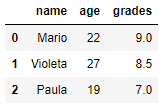
Every bit we can observe, the default alphabetize is merely the row number (an integer index start at 0). Nosotros can modify these indexes by passing the index listing to the DataFrame constructor.
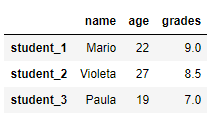
Create a DataFrame from a list of dictionaries
A list of dictionaries can also be used to create a DataFrame, where the keys represent column names. As before, nosotros tin can alter indexes by passing the index list to the DataFrame function.

fifteen. Functions in Pandas that use dictionaries
There are several functions in Pandas that use dictionaries as input values, for example, pandas.DataFrame.rename and pandas.DataFrame.supersede.
pandas.DataFrame.rename
This part returns a DataFrame with renamed axis labels. We can use a dictionary as input where keys refer to the old names and values to the new ones. Labels not contained in the dictionary remain unchanged.
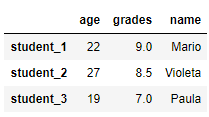
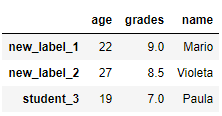
As shown above, we can change alphabetize labels, providing a dictionary to the alphabetize parameter. Alternatively, nosotros can modify column names providing the dictionary to the column parameter.
pandas.DataFrame.replace
This function replaces values of the DataFrame with other values dynamically. Nosotros tin can use a dictionary with the supervene upon role to modify the DataFrame where keys represent existing entries, and values replacement entries.
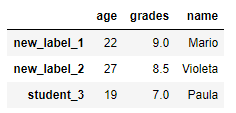
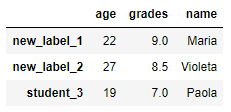
Commodity finished! 🍀 As you tin can come across, dictionaries are a really useful tool in Python. I hope this commodity serves you equally a guideline for taking full advantage of them when coding in Python. 💪
Source: https://towardsdatascience.com/15-things-you-should-know-about-dictionaries-in-python-44c55e75405c
Posted by: rowanopinkh.blogspot.com


0 Response to "Should Nest Boxes Be Cleaned Between Same Year Nesting"
Post a Comment